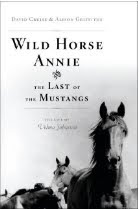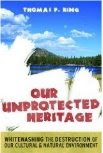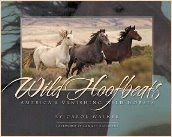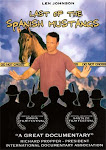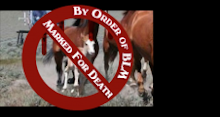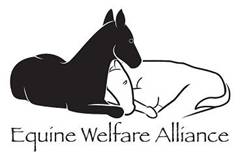A recent Anonymous comment wanted to verify the fact that I filed an appeal to prevent BLM from finally fixing water sources on the Nevada Wild Horse Range. This is a legitimate question and the answer is yes, I have. But as with most BLM sourced information, this is only partially true and I have no doubt BLM intends to have a field day with casting dispersions on my character and concern for the Nevada Wild Horse Range Wild Horses.
The commenter stated this action didn’t sound like anything a wild horse advocate would wish for and they are correct – I have been fighting with BLM for months now to get them to fix the water and apply for water rights as they promised they would do back in 2004. While BLM has had the authority to do this for years, they have not.
The BLM is making claims that they never had the money to fix them until
now, at a time when the Wild Horse & Burro Program is so broke, BLM has announced they need to reduce costs by euthanizing or selling thousands of now captured wild horses and burros in order to relieve the Programs financial pressure.
BLM also told me the money currently available could not be guaranteed past the end of August, which just happened to mysteriously correspond with the opportunity to appeal BLMs Herd Management Area Plan.
Where did BLM get the money
now when the Program is so broke? Is BLM trying to unload every last dollar they have to prove they
are so broke? I really don’t know the answer to these questions but it certainly does offer an interesting paradox, doesn’t it?
What I do know is, so far BLM has failed to make any progress on fixing the water crisis on the Nevada Wild Horse Range, not only over the last several months - but for years - that is until they could legally tier it to the Nevada Wild Horse Range’s new Herd Management Area Plan (HMAP). For the record, BLM actually has authorized these improvements to span 1-5 years in the HMAP, pretty much the same unfulfilled promise they issued in 2004 too.
My appeal is of the Herd Management Area Plan, which I believe wild horse access to water was used as sort of a blackmail tool – no HMAP, no water. I also received a letter last year from BLMs Nevada State Director Ron Wenker stating that generally, BLM did not like to provide “artificial water sources” for wild horses and burros, so I find it odd Director Wenkers stance would change just one year later.
Regarding the water developments, I was forced to appeal the decision of fixing the water because I believe it was only authorized through that horrendous HMAP. However, it is only a Partial Appeal. Specifically, I have asked the court to allow BLM to fix the water developments as long as it did not authorize the Herd Management Area Plan.
If BLM is correct in their assertion that their separate decision allows them to fix the water developments without this action being authorized solely through the new HMAP and its approval, then the judge will rule in BLMs favor and the wild horses will FINALLY get the water that has been promised for so long – assuming they really have the money and aren’t just bluffing.
If BLM has not been honest in their assertion that the water developments are not connected to the HMAP, the judge will (hopefully) not allow BLM to push the approval of the new HMAP through in such a “backdoor” manner by using water as their leverage. Water will still be provided as needed in the same manner BLM has been using since at least 2005 to compensate for their prior deficiencies - by hauling it.
Both the BLM and their attorney contacted me and informed me that I would be responsible for denying wild horses water if I did not withdraw my appeal. I rebutted with a submission to BLM on 7/18/08 that if BLM will issue a new document to authorize the reconstruction of the water developments that was completely disconnected from their new HMAP, I would immediately withdraw my appeal. So far, BLM has yet to respond to this offer “while they still have the money….”
In addition to BLM crafting a horrible HMAP for the Nevada Wild Horse Range wild horses, which recanted promised water sources approved 4 years ago and did not honestly disclose to the public what the No Action existing management really consisted of (approved in the last Resource Management Plan, which actually gave the wild horses more water than the new HMAP does), they also declared an emergency removal was necessary
again (one was conducted in July 2007 as well) due to lack of water and food.
So for all those new found pro-BLM unsubstantiated and unverifiable “Anonymous Researchers” American Herds seems to have picked up lately (the DOI/BLM is the second largest single network now reading American Herds on a regular basis) as well as for the legitimate wild horse advocates that would like to know what has been actually going on in the Nevada Wild Horse Range, listed below is almost every action I have taken regarding BLMs management of the Nevada Wild Horse Range wild horses and burros (the exception being multiple email dialogues with NV WH&B Lead Susie Stokke). This includes letters, public comments, maps and my appeals of what BLM finally decided to do.
June 13, 2007
BLM Nevada State Director Ron Wenkers response to financial offer to help provide water on the range for wild horses.
Click Here to access.
July 31, 2007
After the emergency removals of 178 wild horses in the Nevada Wild Horse Range between July 6-8, 2007 during record heat levels due to lack of water, I wrote a letter to the Las Vegas Field Office, the Humane Society of the United States, and the International Society for the Preservation of Mustangs and Burros expressing concerns for the capture methods and the apparent acceleration of reproduction of mares given PZP during the 2004 round ups. Both BLM and HSUS failed to respond in any manner to this letter.
Click Here to access.
August 13, 2007
Submitted public comments during the Scoping Period for the Preliminary Capture Plan of the Nevada Wild Horse Range wild horses. This included a request for the Rangeland Health Assessment and the documents that approved the allowable population level to be cut in half, from 600-1,000 down to 300-500.
Click Here to access.
September 2007
The Las Vegas Field Office released a Preliminary Capture Plan for the Nevada Wild Horse Range wild horses, expected to be implemented in December 2007. BLM pulled this EA from all normal website access about two months after it was posted. However, here is my copy – Click Here to access.
October 2007
A few days before the public comment period closed, the documents I requested from BLM in August showed up for review. The document that reset the wild horse AMLs (Allowable Management Level) for the wild horse population is titled, “The Nevada Test & Training Range Proposed Resource Management Plan/Final Environmental Impact Statement – 2003” as well as BLMs “Record of Decision” that approved the plan dated July 2004.
To my knowledge, there is no electronic copy of this document available but a hard copy can be requested at: U.S. Department of the Interior, Bureau of Land Management, Las Vegas Field Office, 4701 North Torrey Pines Drive, Las Vegas, Nevada 89130-2301. However, I hand typed a vast portion of the pertinent information from these documents into my appeal and much can be reviewed there.
October 17, 2007
Submitted a 31 page public comment letter to BLMs Las Vegas Field Office expressing my concerns about prior and current management at the Nevada Wild Horse Range. Click Here to access.
December 18, 2007
BLM published an Interested Party Letter postponing the removals of the Nevada Wild Horse Range wild horses and claimed they had intended to provide water tanks at Cedar Well before the summer came in 2008 but the ground was frozen preventing them from any further work. BLM stated they would resume work when the weather would permit it – but as far as I know, they failed to follow through - again! Click Here to access.
January 3, 2008
Sent a letter to the BLM both commending their decision to finally address the long time dysfunctional water systems as well as requesting BLM address the questions I posed during the public comment period in October. BLM failed to respond to this in any manner as well. Click Here to access.
January 31 - March 31, 2008
Dialogue was initiated with NV WH&B Lead Susie Stokke spanning 19 emails requesting more information as well as questions about BLMs management and policies regarding the Nevada Wild Horse Range. On March 31, 2008, Ms. Stokke terminated this exchange stating no further information would be made available until the release of the Preliminary Herd Management Area Plan.
Within these exchanges, the following two responses provided the most specific information about BLMs stance on the on going water issues occurring in the Nevada Wild Horse Range over the last several years. Click Here to access.
Note: It was during this dialogue Ms. Stokke corrected my original statement of 9 wells identified for wild horse use that BLM was suppose to begin development on. The 9 wells were what the Air Force controlled – BLM had only approved of development on 3-4 new wells in 2004.
April 2008
The BLM Las Vegas Field Office releases their Preliminary Environmental Assessment for the new Nevada Wild Horse Range Herd Management Plan. Click Here to access.
May 29, 2008
Submitted 30 page public comment letter protesting BLMs prior land use authorizations, which I believe attempt to set a new precedence in wild horse and burro management and contain legal violations that have potential to have long-term negative impacts to all wild horse and burro habitat throughout the National WH&B Program as well as how they determined the new AMLs in 2004. Click Here to access.
June 23, 2008
BLM releases their approved Herd Management Area Plan for the Nevada Wild Horse Range Wild Horses.
Click Here to access the Final Environmental Assessment.
Click Here to access newly approved Herd Management Area Plan.
Click Here to access BLM Final Decisions for the Herd Management Area Plan and Water Development Reconstruction.
Click Here to access BLMs Question & Answer Sheet – the only document that announces and authorizes wild horse removals from the Nevada Wild Horse Range.
July 10, 2008
Filed Notice of Appeal and Request for Stay of BLMs Herd Management Area Plan. Click Here to access.
Filed Notice of Appeal and Request For Stay of BLMs Reconstruction of Water Developments approved through the Herd Management Area Plan. Click Here to read.
July 16, 2008
Contacted by email (Stokke) and phone by Ms. Stokke and BLMs attorney, the Regional Solicitor. Both stated that if the appeal of the water developments were not immediately withdrawn, the BLM may not have the funding to fix them after the 45 day review time required by the Interior Board of Land of Appeals (IBLA), which would determine if my case is valid.
July 16, 2008
BLM attorney submits an Expedited Motion to Dismiss Request for Stay on Water Developments, urging the court to dismiss it before July 21, 2008. No electronic copy currently available.
July 18, 2008
Faxed request to IBLA for a proper administrative review of the appeal before immediately granting a dismissal. Click Here to access.
July 18, 2008
Emailed Ms. Stokke and BLM Nevada State Director Ron Wenker requesting BLM write a new environmental assessment that authorizes water development maintenance and reconstruction in the Nevada Wild Horse Range that is disassociated with the new Herd Management Area Plan. Click Here to access.
July 21, 2008
Received response from Ms. Stokke regarding BLMs authorization and my questions about lack of proper legal processes to remove wild horses from the Nevada Wild Horse Range. Ms. Stokke included a Memo regarding National Wild Horse and Burro emergency removal policy, IM 2004-151 to support BLMs assertions that removals were conducted legally.
Click Here to access Ms. Stokkes response.
Click Here to access IM 2004-151 Memo and Policy. Review of this policy indicates in this instance, BLM failed to follow their own criteria regarding Escalating Problems, which require an Environmental Assessment be prepared and reviewed by the public before wild horse removals can be initiated.
July 23, 2008
Submitted Full Appeal of the Nevada Wild Horse Range Herd Management Area Plan to the Interior Board of Land of Appeals, 62 pages plus Exhibits. Click Here to access.
July 23, 2008
Submitted Petition for Relief to IBLA regarding BLMs failure to follow appropriate policy and required NEPA documentation for wild horse removals in the Nevada Wild Horse Range. Click Here to access.
July 29, 2008
Letter to Don Glenn, WH&B Division Chief requesting explanation for policy violations in Nevada Wild Horse Range removals. Copies to BLM Director Jim Caswell, Deputy Director Henri Bisson, Nevada BLM State Director Ron Wenker, BLM Las Vegas Field Office Manager, Mary Jo Rugwell. Click Here to access.
Currently waiting on BLMs response to my plea to issue another environmental assessment that authorizes water reconstruction not connected to the new Herd Management Plan as well as BLMs response to the removals of the Nevada Wild Horse Range wild horses that failed to be in conformance with their own policies and regulations.
What Do I Wish For?
That BLM would express the same sentiment about wild horses and burros as they do about cattle when it comes to providing them something as critical as water in the desert on the Nevada Wild Horse Range.
The following excerpts are taking from the Nevada Test & Training Ranges Proposed Resource Management Plan in 2003. In my opinion, these phrases most accurately sum up BLMs difference in attitude about “how” to manage water for wild horses versus cattle in the Nevada Wild Horse Range.
Section 4.4.9, Livestock Grazing Management, pg. 4-9
“The springs and riparian areas are the most important resource, and could be protected with exclosures. Water could be piped outside the exclosures to ensure animals have adequate water supply, therefore not needlessly suffering from severe thirst.” (emphasis added)
Section 4.5.2 Unavoidable Adverse Impacts, pg. 4-14
“Fencing spring and riparian areas would have a direct impact on wild horses that frequent the areas. Some springs would be closed off and no water provided for the horses. There is direct benefit to fencing the spring area to improve the quality of the water and riparian habitat.” (emphasis added).

~Additional Resources for the Nevada Wild Horse Range~
*BLMs Herd Management Area Description: BLM states wild horses travel up to 15 miles a day during the summer for forage. The new HMAP will only measure forage utilization for all species within a 1-3 mile radius of their few remaining water sources – 50% utilization/all species/new growth only. Click Here to access.
*Nevada Wild Horse Range 1997 Evaluation: Includes recommendation to not manage for wild horses as well as expressing concerns about prior decisions regarding age and gender structures having compromised herd integrity. Also cites the need to address water developments within the NWHR. Click Here to access.
*BLM Press Release: States fertility control experiments were being conducted on wild horse herds as early as 1992. It is currently not known what form of immunocontraception was being used at this time. Click Here to access. The 1998 Nevada Wild Horse Mangement Plan For Federal Lands - Draft, stated the Nevada Wild Horse Range wild horses were one of two herds studies were conducted on using immunocontraceptives as of 1992. (pg. 20, pg. 41) Jay Kirkpatrick has confirmed that PZP was administered to Nevada Wild Horse Range mares in 1996 (see Exhibit II in HMAP Appeal) and BLM also administered PZP in 2004.
*Nevada Commission for the Preservation of Wild Horses – Meeting Minutes, November 14, 2003, pg. 4: Administrator Barcomb expresses concerns about BLMs prior use of fertility control drugs administered to the Nevada Wild Horse Range mares during a critical period with absolutely no follow up or monitoring. Click Here to access.
*Draft Environmental Assessment, Integrated Natural Resource Management Plan, Nellis Air Force Base and Nevada Test and Training Range, NV, May 2007, Wild Horses, pg. 41. Click Here to access.
UPDATE
August 13, 2008
Though BLM issued two separate decisions, the Interior Board of Land of Appeals combined both decisions, Requests for Stay and Appeals into one case versus two and docketed both under IBLA #2008-201. Originally docketed under the heading of Herd Management Plan, IBLA changed it too Water Developments and in their final ruling, lumped all three appeals together and issued a decision on them collectively under the title of Wild Horse Management.
*Submitted additional evidence regarding appeal of Nevada Wild Horse Range Herd Management Plan to Interior Board of Land of Appeals, IBLA #2008-201. Click Here (Minus some Exhibits due to limited space in web format)
*Submitted additional evidence regarding Partial Appeal of Nevada Wild Horse Range Herd Management Plan Water Developments. Click Here (Minus some Exhibits due to limited space in web format)
*On August 10, 2008, discovered IBLA had accepted my Petition for Relief regarding BLMs "Emergency Removals" and had docketed my petition under a separate case, IBLA #2008-233. As a result, I submitted a Notice of Intent to Respond on August 13, 2008 regarding BLMs "Emergency Declaration" of removals from the Nevada Wild Horse Range. Click Here.
August 19, 2008
Submitted Full Appeal of Nevada Wild Horse Range "Emergency Removals". Click Here
August 20, 2008
Submitted a "Correction Letter" as three Exhibits failed to be included in the electronic Exhibits CD submission. Click Here
September 5, 2008
Interior Board of Land of Appeals combines all three cases into one and issues the decision in favor of BLM on all counts based on the following criteria:
~I had no legal standing or rights to appeal the decision because I was not authorized to enter the Nevada Test and Training Range.
~I failed to prove I was adversely effected by BLMs Herd Management Plan.
~Because the Nevada Wild Horse Range Herd Management Area Plan was linked to the 2004 Resource Management Plan and Record of Decision, a decision I spent extensive time showing was both seriously flawed with multiple errors, IBLA ruled any discussion about the RMP had been submitted to the wrong court and any evidence or connection of the new HMAP to the RMP would not be considered.
~The public cannot appeal any action by BLM if BLM failed to sign a document stating they would take a specific action, even if BLM submitted evidence to IBLA themselves that verified they took that action.
Click Here to review IBLA's decision in full.
While IBLA did spend time reflecting on my "passion" for wild horses and burros, they obviously did not consider it equally necessary to reflect on the hundreds of pages of science, data, facts, or the DOIs and/or BLMs own laws and regulations they are supposedly required to abide by and which IBLA is charged with overseeing their compliance too.
Nor did IBLA seem to be interested in giving equal consideration to basic humane standards and treatment of the wild equines wholly dependent on BLMs care, blatant violations of accepted standards for proper animal husbandry legally required by both federal and Nevada law or BLMs egregious abuse of tax payer funded power, which these days is used as a hammer versus a gavel.
To the casual observer reading IBLAs ruling, this is yet another case of yet another one of those "fringe" sentimental wild horse lovers unsubstantiated, ungrounded, emotionally based protests, once again relegated to the ever-popular "passionate" stereotype that just "doesn't understand" BLMs supreme wisdom and multiple-use mandates. They use this denigrating soundbyte repeatedly because it works, doesn't it? And I've heard it used dozens of times now....With a wink and a smile, it says it all ~
Those crazy "passionate" horse advocates!
Unless anyone wants to take the time to read through the facts and wants to know the truth (or at least a lot closer version of the truth than they are willing to tell!) about what has been done and what has now been "approved" for America's oldest "protected" wild horse herd.
Let this story bear witness to how they were taken out.....
 There may be vehement opposition by the public lands ranching industry to the idea of actually having to pay the full amount of $1.35 to feed a cow and calf per month without getting the “bonus forage” for free as described in the last post, “Get One Free!”.
There may be vehement opposition by the public lands ranching industry to the idea of actually having to pay the full amount of $1.35 to feed a cow and calf per month without getting the “bonus forage” for free as described in the last post, “Get One Free!”.









